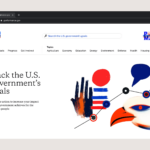This article is posted with permission from our partner MacPaw. MacPaw makes Mac + iOS apps that have been installed on over 30 million devices worldwide. Freelancers Union members receive 30 days of free unlimited access to CleanMyMacX and Setapp: https://freelancersunion.org/resources/perks/macpaw/
Identity theft happens when someone uses your personal information to impersonate you and commit fraud. It’s a common problem that can seriously impact your life. When you see its signs, it’s important to act quickly.
Reviewing your credit reports, monitoring your accounts, and reporting the theft to the proper authorities can help limit the damage. Moonlock, a cybersecurity division of MacPaw, has prepared a guide on how to take proactive steps to protect yourself.
Signs that your identity has been stolen
Identifying the signs of identity theft is tricky, especially when you don’t know what to look for. Here, you’ll find the most common ways to spot identity theft, wrapped into short stories from fictional characters so it feels easier to share with others and remember.
Credit accounts you didn’t open
Sarah Chen, Graphic Designer from Portland
“I never thought it would happen to me, you know? I was working late one night on a client project when I got this weird email from my bank about a credit card application. Thing is, I hadn’t applied for any new cards. When I checked my credit report, there were three new accounts I’d never opened. Someone had been using my information to open credit cards all over the place.”
Redirected mail
Marcus Rodriguez, Independent Software Developer in Austin
“It started with just a missing piece of mail. I was waiting for a tax document I needed for a client invoice, but it never showed up. Then another important letter went missing, and another. Turns out someone had redirected my mail to a different address. They were collecting all my personal information. I only caught it because I decided to go paperless with most of my accounts and noticed the mailing address had been changed without my knowledge.”
Debt collection
Emily Thompson, Freelance Writer based in Chicago
“I started getting these calls about unpaid bills I knew nothing about. At first, I thought they were scam calls – we freelancers get those all the time, right? But when I looked into it, someone had racked up thousands in debt using my name. It took months to sort out, and during that time, I was stressed about how this would affect my ability to get a business loan.”
Lost identity documents
David Park, Independent Photography Consultant in Miami
“I always keep my important documents in a small safe at home. One day, I needed my social security card for a new client contract, but I couldn’t find it anywhere. I tore my home office apart, looking for it. A week later, I started seeing strange purchases on my bank statement – photo equipment from stores I’d never visited. Someone had somehow gotten hold of my card and was living it up buying camera gear.”
Denied loans or credit
Lisa Martinez, Freelance Marketing Strategist in Denver
“I found out something was wrong when I tried to get a small business loan to expand my marketing consultancy. The bank turned me down, which was shocking because I’ve always had excellent credit. When I pulled my credit report, I saw all these hard inquiries I hadn’t made. Someone had been trying to open multiple lines of credit using my information. As someone who works for themselves, maintaining good credit is crucial – this could have seriously impacted my business if I hadn’t caught it early.”
What can lead to a stolen identity
Phishing is not the only way to trick you into sharing your personal information. Here are the most common ways cybercriminals use to take advantage of everything you’ve earned in life:
Dumpster diving
While most people focus on protecting themselves from online scams, experienced thieves know that residential trash bins can be goldmines of personal data. Discarded pre-approved credit offers, bank statements, and credit card bills contain valuable information that can be exploited for fraud.
Social media scanning
How often does the name of your first pet become an answer to a security question? Or the name of your mother? Both of these names seem innocuous to share with your social media connections, but once they are in the wrong hands, they become tools to impersonate you and cause significant damage.
Familiar fraud
Also known as family identity theft, it happens when someone close — like a parent, spouse, or caregiver — uses another’s personal information for financial gain. This can involve opening credit cards or loans, making large purchases, or even receiving medical care in the victim’s name. Because the perpetrator has the victim’s trust and has easy access to personal details, familiar fraud can go undetected for years, leaving victims with damaged credit and financial setbacks.
Data breach
2024 has proved to be the year of data breaches. In January 2024, cybersecurity experts named one “The Mother of All Breaches,” offering a staggering 26 billion records of personal information on the dark web.
Unfortunately, victims of identity theft are significantly more likely to discover that their personal information has been involved in a data breach. Retailers, hospitals, government offices, and colleges are often responsible for your key information being leaked as a result of a breach.
Social engineering
Smishing, vishing, phishing, whaling, pretexting – there are many ways to trick you into giving away your personal information by pretending to be someone you trust. Those we just mentioned are just the tip of the iceberg of many social engineering tactics that can result in identity theft.
Hacking your device
While less common than phishing, scamming, and physical theft, identity thieves may hack into your computer to obtain your personal information. For example, they might access one of your devices in a coworking space while you step away from your laptop to pour some coffee. Once they do, they could install malware that transmits all the data you input back to them.
Identity theft response and an emergency action plan
When your identity falls into the wrong hands, every minute counts. Moonlock compiled this guide to walk you through the essential steps to minimize damage.
Immediate actions (first 24 hours)
Notify your bank. Don’t wait – contact your bank immediately. Request an immediate pause on pending transactions and explain the situation. They’ll typically implement enhanced security measures for your account, requiring stricter verification for any new activity.
Implement a credit freeze. Your next crucial step is to secure your credit files. Contact all three major credit bureaus: Experian, Equifax, and TransUnion. Each bureau needs to place a security freeze on your credit file. This creates a protective barrier, making it nearly impossible for criminals to open new accounts in your name since creditors won’t be able to access your credit information.
Official reporting process
After securing your immediate financial assets, document the crime. File a report with the FTC identitytheft.gov, ID Theft Resource Center idtheftcenter.org or 888.400.5530, and your local police department. You can use the same contact information to report if you had any identity documents stolen or lost.
Account protection strategy
Conduct a thorough security overhaul of your digital presence. Create a comprehensive list of accounts that need attention:
- Financial institutions
- Credit card providers
- Store credit accounts
- Online shopping platforms
- Social media profiles
Contact each organization to implement additional security protocols. Update login credentials for all potentially compromised accounts:
- Change passwords.
- Update usernames if possible.
- Consider switching associated email addresses.
- Enable two-factor authentication where available.
Quick action combined with thorough follow-through gives you the best chance of minimizing damage and protecting your identity from further exploitation.
How to prevent identity theft
Sadly, identity theft is a daily reality that requires your attention. While you can’t make yourself entirely immune to sophisticated thieves, you can build a strong defense system that significantly reduces your risk. Let’s explore how to protect yourself through simple, everyday actions.
Shred your papers
Your first line of defense begins at home. Think of sensitive documents as valuable currency — because, to thieves, that’s exactly what they are. Instead of tossing bank statements, credit card offers, and utility bills directly into the trash, invest in a quality shredder. This simple tool transforms sensitive paperwork into useless confetti, leaving dumpster-diving thieves empty-handed.
Lock your documents
Just as you wouldn’t leave cash lying around, your vital documents deserve a secure home. A fireproof safe or safety deposit box can protect your passport, Social Security card, and birth certificate. The rule is simple: if a document could help someone pretend to be you, it must be secured.
Contact credit bureaus regularly
Your credit report is like a financial diary — it tells the story of your identity’s health. Make regular check-ups with all three major bureaus (TransUnion, Experian, and Equifax) part of your routine. Watch for unfamiliar accounts, mysterious address changes, or any activity that raises an eyebrow. Early detection can prevent a small problem from becoming a crisis.
Putting a credit lock at each credit bureau would be even better. If your credit report accounts are locked, identity thieves will find it more difficult to take out credit in your name.
Visit here to set up Equifax file locking.
Visit here to set up TransUnion file locking.
Visit here to set up Experian file locking.
Don’t overshare on social media
In our sharing culture, it’s tempting to broadcast personal details online. However, identity thieves are masters at piecing together digital breadcrumbs into a complete picture of your identity. Share thoughtfully and sparingly. Remember: not every detail of your life needs to be public knowledge.
Physical mail remains a golden opportunity for identity thieves. When moving, update your address with every organization that might mail you. Set up USPS mail forwarding to ensure no sensitive documents fall into the wrong hands. Consider it a critical part of your moving checklist, just as important as packing boxes.
Scan your device for malware
Spyware is a common tool for identity thieves to steal personal information. That’s why it’s important to install a malware scanner on your device and regularly check it for malware. CleanMyMac is an easy way to do this if you own a Mac computer. Its Malware Removal tool is powered by Moonlock Engine and detects even the latest type of malware lurking across the web.
Protecting your identity is an ongoing process, not a one-time task. By making security part of your daily life, you create a robust defense against those who would steal your personal information. Start implementing these practices today — your future self will thank you for the protection.



